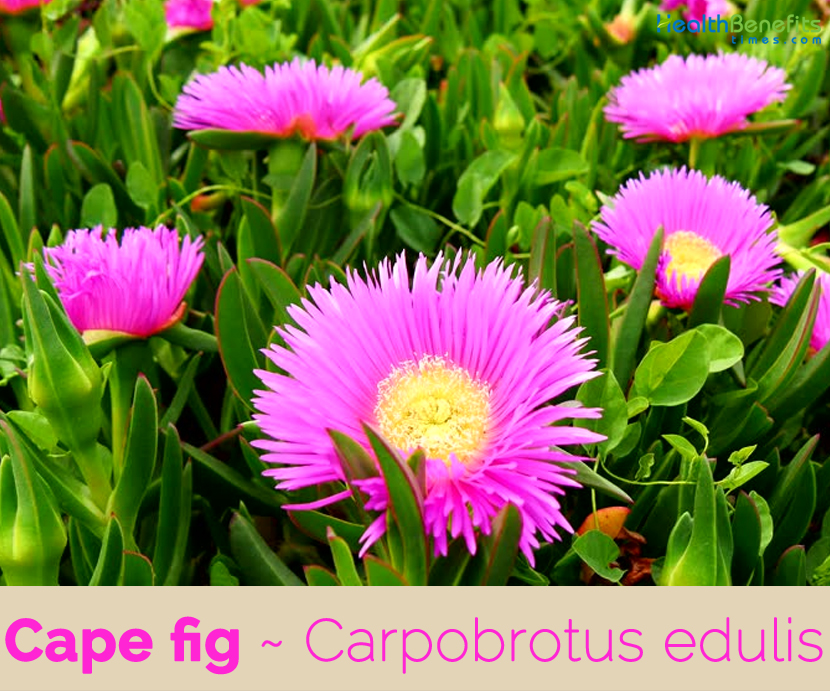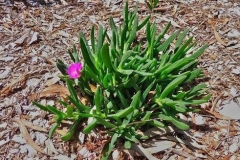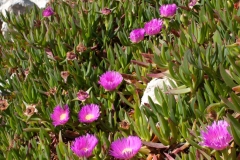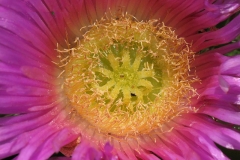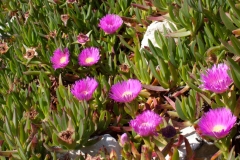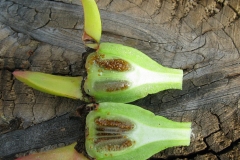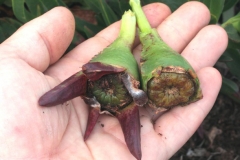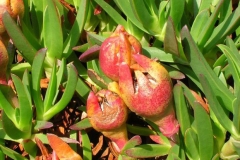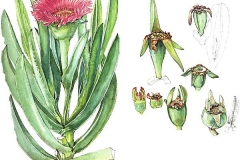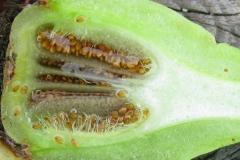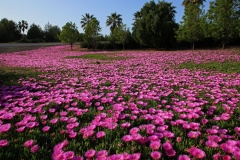| Cape fig Quick Facts |
| Name: |
Cape fig |
| Scientific Name: |
Carpobrotus edulis |
| Origin |
South Africa, but has naturalized in many cooler, very sandy soiled, Mediterranean regions of California and Australia |
| Colors |
Green when young turning to yellow as they mature |
| Shapes |
Fleshy, indehiscent and edible fruit, 1.4 inches (3.5 cm) in diameter, shaped like a spinning top, on a winged stalk |
| Taste |
Salty and tangy taste |
| Health benefits |
Beneficial for burns, bruises, scrapes, cuts, grazes and sunburn, ringworm, eczema, dermatitis, sunburn, herpes, nappy rash, thrush, cold sores, cracked lips, chafing, skin conditions and allergies |
Carpobrotus edulis, Cape fig or Hottentot fig, is a ground-creeping plant is a member of the fig-marigold family Aizoaceae, one of about 30 species in the genus Carpobrotus. It was previously classified in Mesembryanthemum and is sometimes referred to by this name: Mesembryanthemum edule. It is a creeping, mat-forming herb native to South Africa, but has established in many cooler, very sandy soiled, Mediterranean regions of California and Australia. Few of the popular common names of the plant are Cape fig, Fig-marigold, Highway ice plant, Hottentot fig, Ice plant, Sour fig, Pigface, Yellow-flowering sour fig, Freeway iceplant, kaffir fig and introduced pigface. The name Carpobrotus means ‘edible fruit’.
Carpobrotus is derived from the Greek word karpos, meaning fruit, and brotos, meaning edible. The Latin words, edulis, means edible, and parviflorus means with small flowers. The Afrikaans common names ghaukum and ghoenavy come from old Khoi names for the plant. The name Hotnotsvy (Hottentots fig) was in use as long ago as 1685 and is probably derived from the fact that the colonists observed the Khoikhoi using this plant and eating its fruits. It got the name vy (meaning fig and pronounced fay) because the developing fruits superficially resemble figs but it is in no way related to figs (Ficus species, family Moraceae, the mulberry and fig family). It is now considered to be an invasive plant by the California Invasive Plant Council.
Plant Description
Cape fig is a moderately vigorous, creeping, upright branched, mat forming succulent species and member of the fig-marigold family Aizoaceae that grows about 1 foot tall and about 5 feet wide. The plant is found growing in coastal dunes, coastal habitats, on cliffs, sand-dunes, salt marshes, coastal scrubs, roadsides and railway lines inland, winter-wet depressions, sandy pastures, open woodlands, cliffs and river estuaries. The plant prefers flat, sandy ground, on loose sand dunes, lime-rich and brackish soils, and gravelly gardens, as well as in containers, rockeries, and embankments, and will cascade over terrace walls. The plant has shallow and fibrous roots. Stems are spreading or prostrate, about 8-13 mm in diameter and up to 2 m long forming large mats, sometimes rooting at the nodes.
Leaves
The fleshy (i.e. succulent) leaves are stalk less (i.e. sessile) and oppositely arranged along the stems. Elongated leaves are succulent, up to 5 inches (12.5 cm) long and up to 0.5 inch (1.2 cm) thick, sharply 3-angled and triangular in cross-section, opposite, slightly connate at the base, bright green or slightly glaucous, waxy, often tinged red along edges and becoming generally reddish or orange with age. Adaxial and lateral surfaces are distinctly concave; keel denticulate, sometimes only in upper portion; tips obtuse to acute. The stems and leaves are also hairless (i.e. glabrous).
Flower
The large and showy yellow flowers (7-8.5 cm across) are borne singly at the tips of short side branches (i.e. solitary and terminal on lateral branches). They are borne on a fleshy stalk (i.e. they are pedicellate) and have numerous false ‘petals’ (30-35 mm long and 1.5-2.5 mm wide). The true petals resemble the fleshy (i.e. succulent) leaves and their bases are fused into a tube (i.e. perianth tube) 15-25 mm long around the ovary. Two of these petals are larger about 20-45 mm long, almost opposite and closely resemble the leaves. The structures that mimic petals are actually derived from modified stamens (i.e. they are petaloid staminodes). There are about 120-130 of these in each flower and they are arranged in 3-5 rows. They are yellow with whitish colored bases, but may turn pinkish with age. Each flower also has very large numbers of stamens (i.e. approx. 400-600) that are arranged in about 6 or 7 rows. The ovary has 8-10 compartments and is topped with the same number of styles (7-15 mm long). The flowering period extends from late summer to winter.
Fruits
Fertile flowers are followed fleshy (i.e. succulent), globular or sub-globose fruit that is about 1.4 inches (3.5 cm) in diameter, shaped like a spinning top, on a winged stalk. Fruit is initially green turning to yellowish to reddish-purple in color as they mature. These fruit consists of numerous seeds that are embedded in the sticky, sweet, jelly-like mucilage. The fruits can be eaten fresh and they have a strong, astringent, salty, sour taste. They are not as tasty as those of C. acinaciformis and C. deliciosus which are sweeter.
Types
1. Carpobrotus acinaciformis
Carpobrotus acinaciformis has purple flowers, robust, short, greyish green, sabre-shaped leaves and tasty edible fruits. It is used to make a delicious jam, and grows in coastal sands usually close to the sea, in the Western Cape, from Saldanha to Mossel Bay.
2. Carpobrotus deliciosus
Carpobrotus deliciosus has purple, pink or white flowers, almost straight, reddish green leaves and sweet fruits that make excellent sour fig preserve. It grows on sand dunes and in rocky grassland along the southern and eastern coast of South Africa from Riversdale in the Western Cape through the Eastern Cape to KwaZulu-Natal.
3. Carpobrotus dimidiatus
Carpobrotus dimidiatus has rose-purple flowers and grows on dunes in the Eastern Cape to KwaZulu-Natal and Mozambique.
4. Carpobrotus mellei
Carpobrotus mellei is the only species that occurs in the fynbos on sandstone mountain slopes inland, it is found only in the Western Cape in the Hottentots Holland Mountains, the Langeberg and the Swartberg. It has pink or purple flowers, narrow small leaves and a small club-shaped fruit.
5. Carpobrotus muirii
Carpobrotus muirii is similar to Carpobrotus deliciosus but has narrower leaves and is only found only in the Strandveld in the Western Cape, from De Hoop to Stillbaai.
6. Carpobrotus quadrifidus
Carpobrotus quadrifidus (including C. sauerae), has large violet-pink, pale pink or white flowers-the largest flower found in the family Mesembryanthemaceae-and straight, stubby grey leaves and grows in sandy lowlands along the west coast from southern Namaqualand in the Northern Cape to Saldanha in the Western Cape.
Traditional uses and benefits of Cape Fig
- Leaf juice is mixed with water and swallowed to treat diarrhea, dysentery and stomach cramps.
- It is used as a gargle to relieve laryngitis, sore throat and mouth infections.
- Chewing a leaf tip and swallowing the juice is enough to ease a sore throat.
- Leaf juice or a crushed leaf is a famous soothing cure for blue-bottle stings-being a coastal plant it is luckily often on hand in times of such emergencies.
- Leaf juice is used as a soothing lotion for burns, bruises, scrapes, cuts, grazes and sunburn, ringworm, eczema, dermatitis, sunburn, herpes, nappy rash, thrush, cold sores, cracked lips, chafing, skin conditions and allergies.
- An old and apparently very powerful remedy for constipation is to eat fruits and then drink brackish water.
- Syrup made from the fruit is said to have laxative properties.
- Mixture of leaf juice, honey and olive oil in water is an old remedy for TB.
- Leaf juice also relieves the itch from mosquito, tick and spider bites both for people and their animal companions.
- The Khoikhoi took an infusion of the fruits during pregnancy to ensure a strong, healthy baby and an easy birth and muddy leaf sap over the head of a new-born child to make it nimble and strong.
- In the Eastern Cape it is also used to treat diabetes, and diphtheria.
- Sap obtained from the leaves is antiseptic which can heal wounds, insect bites and stings by applying it on the skin.
- Juice from the leaves also has astringent properties which helps soothe the skin.
- Respiratory blocks can be treated by inhaling the steam after boiling the leaves.
- It can be used for making skin ointments which can effectively treat psoriasis and other skin ailments.
- Sun burns might be treated using extracts of this plant.
- Natives in Eastern Cape use it as remedies for disorders like diphtheria and diabetes.
- For constipation, an age old remedy was to consume the fruit followed with salty water. A known laxative is syrup made from it.
- As the leaves are antiseptic, their juice can be mingled in water and gargled to alleviate sore throat and mouth infections.
- Leaves are very useful component of this plant that has been used for addressing cystic ailments and pulmonary disorders.
- Fresh juice of the leaves or preparations based on the fruit is currently used for gargles, as a mouthwash or antiseptic solution.
- Leaf juice is also applied for the treatment of sores and wounds from scalds or burns, and as a cicatrizant.
- Fruit preparations are used orally for the treatment of tuberculosis or other’ lung infections.
- Mixed preparations of leaves and fruit of Hottentot figs are generally administered for treating heart diseases and are used as mouthwashes or for gargles in the case of sore-throats or stomatitis.
- Astringent juice of the leaves has been used to treat cuts, eczema, insect bites, ringworm and sunburn, and taken with water, it has been used for diarrhea and sore throat.
Culinary uses
- Fruit can be consumed raw, cooked, dried for later use or made into pickles, chutney etc.
- There is very little flesh in the fruit and it must be fully ripe otherwise it is very astringent.
- Leaves can be consumed raw or cooked.
- Succulent, they are eaten in salads and can also be used as a substitute for pickled cucumber.
- In South Africa the astringent fruits are made into jam, pickle or chutney.
Other facts
- Each fruit consists of between 1000 and 1800 seeds.
- It is used in maritime areas to prevent soil erosion in sandy soils.
- Plants form a dense carpet and make an effective ground cover.
- It can be grown as a fire barrier in areas subject to forest fires, it is moderately fire retardant.
- It is a popular plant for growth as an ornamental or for ground cover.
- Curries can also be made with the fruit.
- Due to its showy features, this plant had been planted in gardens and sold via nurseries.
- The plant can efficiently tighten soil and act as an embankment stabilizer apart from being draught-resistant, which is why they are cultivated.
- They can also help in stopping forest fires from spreading, which is another reason why they are grown.
Different Methods of Controls
Physical control
a. Manual methods
Cape fig is easily removed by hand pulling, making it a good target for community or school group restoration projects. Because the plant can grow roots and shoots from any node, all live shoot segments must be removed from contact with the soil to prevent re-sprouting. If removal is not possible, mulching with the removed plant material is sufficient to prevent most re-sprouting, but requires at least one follow-up visit to remove re-sprouts.
b. Mechanical methods
Mechanical removal by bobcat or tractor is effective for areas in which there are no sensitive resources, though in order to prevent significant soil removal, the use of a brush rake attached to the scoop is recommended. Mechanical removal is effective at any time of year.
c. Prescribed burning
Because of the high water content of shoot tissues, burning of live or dead plants is not a useful method of control or disposal. Attempts to control Carpobrotus edulis by solarization or freezing also have been found to be ineffective.
Biological control
a. Insects and fungi
There are currently no biological controls for Carpobrotus edulis. The iceplant scale insects, Pulvinariella mesembryanthemi and P. delottoi, have a small impact on some individuals, but would likely not be useful as a control tool. Additionally, occasional parasitism by dodder can be seen, but its impact appears to be minimal.
b. Grazing
Because of the salty and astringent quality of the leaves and the fibrous to woody quality of stems, grazing is improbable to be an effective control for Cape fig.
Chemical control
The herbicide glyphosate has been effectively used to kill Carpobrotus edulis clones at concentrations of 2 percent or higher. Addition of 1 percent surfactant to break apart the cuticle on the leaves increases mortality. Mortality reportedly is greater when the water utilized is more acidic. Adding an acidifier to hard water before mixing with glyphosate can increase the effectiveness of the treatment. It takes several weeks for the clones to die off, and re-sprouting can occur from apparently dead individuals for several months afterward. Spraying should be avoided in areas in which native species are interspersed with Cape fig clones. Impacts to native species can be reduced by treating Cape fig in early or mid-winter when most native plants are dormant. Subsequent growth from seedlings needs to be controlled.
References:
https://www.itis.gov/servlet/SingleRpt/SingleRpt?search_topic=TSN&search_value=19934#null
https://davesgarden.com/guides/pf/go/2024/
http://www.hear.org/pier/species/carpobrotus_edulis.htm
https://pfaf.org/user/Plant.aspx?LatinName=Carpobrotus+edulis
https://www.cabi.org/ISC/datasheet/10648
http://www.floracatalana.net/carpobrotus-edulis-l-n-e-br-in-phillips
https://plants.usda.gov/core/profile?symbol=CAED3
http://www.public.asu.edu/~camartin/plants/Plant%20html%20files/carpobrotusedulis.html
http://www.theplantlist.org/tpl/record/kew-2701245
https://en.wikipedia.org/wiki/Carpobrotus_edulis
http://pza.sanbi.org/carpobrotus-edulis
http://www.europe-aliens.org/pdf/Carpobrotus_edulis.pdf
Comments
comments


